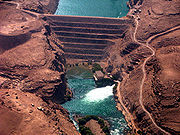Military activity in Afghanistan: updated to 7th July
The post about military activity in Afghanistan (and the maps) has been updated, now it covers until 7th July (lacks some days).
This blog is about conflict regions of the world. It addresses relevant events, involved people, military activity & issues, as well as the underlying geopolitics. The blog also geo-references the information using google maps and google earth library.
The post about military activity in Afghanistan (and the maps) has been updated, now it covers until 7th July (lacks some days).
Posted by
Raul
at
1:48 AM
29
comments
![]()
Labels: Afghanistan, Map, Military
NATO-ISAF airstrikes in Haidarabad village (Haydarabad, Ḩeydarābād, Hyderabad, Heydarabad, Khaidarabad) left at least 30 civilians killed or wounded on Friday June-29.
Haidarabad is at Gereshk district (Helmand province). Follow this link to see the map of Haidarabad.
Taliban forces tried to ambush an US-Afghan military convoy in Gereshk district, and then they ran to the nearby village for cover. Then, NATO-ISAF attacked the village with airstrikes, said Dur Ali Shah, the mayor of Gereshk.
NATO-ISAF spokesman stated that a dozen of Taliban were killed in two engagements, but they weren't aware of civilian casualties.
Local sources stated that there have been intense fighting in the area, and there would be about 100 people killed.
This incident is one more in a long list. Last week, president Karzai criticized the ISAF "extreme" use of force.
Read more here:
- About the incident at Haidarabad: [Afgha News] [Yahoo News] [Bassirat.net] [BBC News] [El Mundo] [New York Times] .
- A local investigation reported that 62 insurgents and 45 civilians were killed in the operations [Yahoo News, Sunday 1st July].
- NATO-ISAF operations with civilian deaths : Civilian deaths and friendly fire on ISAF operations (Afghanistan) [updated] , Civilians killed by NATO at Afghanistan : the case of Zerkoh Valley (Shindand, Herat) .
Posted by
Raul
at
11:01 AM
0
comments
![]()
Labels: Afghanistan, Civilian, Map, Military
The latest news about military activity in Afghanistan state that:
Posted by
Raul
at
12:24 AM
1 comments
![]()
Labels: Afghanistan, Central Asia, Map, Military
ISAF spokesman Nick Lunt responded that: "President Karzai has a right to be disappointed and angry over the scale of civilian casualties in the last few days," "We need to do better than we have been doing so far." [Yahoo News].
--------------------------------------------------------------------------------------------
Posted by
Raul
at
7:24 PM
1 comments
![]()
Labels: Afghanistan, Central Asia, Military
Kajaki dam, a key facility at southern Afghanistan, is still a fighting place between ISAF and Taliban.
Kajaki dam is is one of the major hydroelectric power dams of Helmand province, and also serves to irrigate 1800 km² of land. The dam is 100m high and 270m long, and has a capacity of 1.2 km2 of water. Then, this dam is a key facility for the development plans of the Afghan government and its allies.
The pictures [Wikipedia] show the dam and the powerhouse. The dam was built in 1953. In 1975, USAID supported the installation of two generators of 16.5 MW. In October 2001, the powerhouse was bombed by US Air Force.
The dam was built in 1953. In 1975, USAID supported the installation of two generators of 16.5 MW. In October 2001, the powerhouse was bombed by US Air Force.
Now, one generating unit is working and produces 16.5 MW. A second one is scheduled to return to service in 2007. And a third one (18.5 MW) is has been contacted China Machine Building International Corporation, and it is planned to be completed in 2007.
Kajaki dam has been a fighting place between ISAF and insurgents. In December 2006, Britan's commander stated that the area were fully controlled by ISAF. But the claim showed to be premature in February, when Taliban seized several towns. During February 2007, ISAF forces executed Operations Kryptonite and Volcano. These operations focused on some villages at the north-west of the dam, which were occupied by Talibans. The main battles occurred at Barikju, Chinah and Shomali Ghulbah.
The map below shows the main places in the area.
After the operations of February, the situation seemed to be under ISAF control. But recent military actions show that the area is still in middle of fighting.
In the last two weeks there have been several air strikes or similar operations.
Posted by
Raul
at
12:45 AM
77
comments
![]()
Labels: Afghanistan, Central Asia, Map, Military
Posted by
Raul
at
1:29 AM
1 comments
![]()
Labels: Afghanistan, Central Asia, Map, Military
Posted by
Raul
at
11:44 PM
1 comments
![]()
Labels: Central Asia, Geopolitics, Map, Military
Asia Pacific: Tamilnet (Sri-Lanka Tamils) ,
East Africa: Somalinet,
Caucasus: KavkazCenter ,